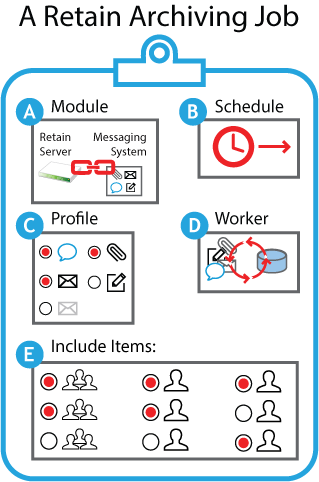6.1 Understanding Retain Jobs
If your messaging platforms require job-based archiving, you need a basic understanding of Retain Jobs and their components: modules, schedules, profiles, and workers, as illustrated in Figure 6-1 and explained in Table 6-1.
Figure 6-1 The Components That Make Up a Job

Table 6-1 Job Component Information and Links
|
Letter |
Brief Description |
|---|---|
|
A |
Retain Modules are the foundation that links messaging systems to Retain. To set up a Job, you must first create a Module for the targeted messaging system, so that the Retain Server can connect to it. Each module is as unique as the system it represents. Both Retain archiving models require a module. For Job-based archiving, you cannot create Profiles or Jobs until after you create platform-specific Modules for them. After you complete the instructions in this chapter, you will continue with Section 6.0, Setting Up Job-Based Archiving, which contains module-creation instructions. |
|
B |
The Schedule is the time framework that is set for the job to run on and provides the choice of how often, and when, the job is run. Single time, (job runs once), or a recurring time frame are available. Schedules are universal and are not module or job specific. They may be used for one or all jobs. HINT:The order implied by the letters in Figure 6-1, reflects the process of creating jobs, beginning with module creation. However, as a best practice, we recommend that you start by planning the best times for your jobs to run and creating schedules that reflect your plans. Schedules control when a Job’s data collection processes start. Schedules are independent components that are not tied to specific jobs or modules. Schedules can be one-time or repeating and can be created, modified, and deleted as needed (providing they are not used by other Retain components. For instructions on creating schedules, see Creating the Required Schedules. |
|
C |
The Profile dictates which kinds of files to retrieve from the message system. All message system items are selectable to be archived, but you may also specify time periods, exclude folders or subjects, and how the data is stored. Profiles are module specific, and the profile section contains sections specified by each module and information only applicable to that module. The Profile also has a very important function, duplicate checking. This keeps the Retain system from storing multiple instances of the same message. Make sure you check and read the section on Purge (GroupWise), Retention (GroupWise), and Item Store (Exchange/GroupWise) flags. Profiles detail which types of messages and data a job is to archive. The dialogs for creating a platform’s Profile appear only after you create a Module for that platform. Profile instructions are contained in their relevant platform sections. |
|
D |
The worker is the part of Retain that actually pulls the data from the message system servers. The Worker contacts the Retain Server and gathers information on which jobs are associated with it, when to start them, and which items to get. Workers can only run one job at a time. Workers are not module specific, but may require module specific settings. These settings, where applicable, are found under the module specific tab. A Worker has two parts:
When possible, workers should be installed on the messaging system they service. Workers only start archiving after an associated job is created successfully. Instructions for creating and setting up Workers are found in Creating Workers. |
|
E |
The Jobs section is where the Worker, Profile, and Schedule are all brought together and associated into a comprehensive configuration by allowing the user to tie their configuration to a selected SecureLine server and selected user list. The desired SeucureLine server must be selected. The Worker will not start archiving anything until a created job is bound to a Worker, Schedule, and Profile. You can create jobs only after you have all of the other components in place. During Job creation, you specify which mailboxes (users and groups) on the targeted systems Retain will archive. Jobs are tied directly to modules. If you want a Job to include multiple modules, you must select the modules by name before creating the Job. Instructions for creating jobs are contained in their relevant platform sections. |